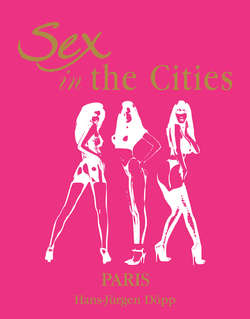Читать книгу Sex in the Cities. Volume 3. Paris - Hans-Jürgen Döpp - Страница 6
History: Middle Ages, Renaissance
François Villon
ОглавлениеIs Paris the Babel of sin? Observing the degeneration of morals, a 15th-century priest exclaims with disgust: “Oh, my God! I do not think that since the days of our Lord Jesus Christ vice has ever reigned anywhere in such profusion as it does now in Paris…” It was this Paris into which Villon was born.
François Villon was born in Anvers, near Paris, in 1431. He attended the University of Paris, which was founded in 1150, and is thus one of the oldest in Europe. The loose life led by students at that time attracted him more than the acquisition of knowledge itself. The district around the university was the noisy centre of all pleasures and lewdness at that time – what one might call the Montmartre of his époque.
For the students, the art of living in a pleasurable, dissolute way meant more than the pursuit of knowledge. As early as the 12th century, word went out from students in Paris that they preferred to contemplate the beauties of prostitutes rather than those of Cicero. From amongst them, it was mainly the clerics and “scribes” – that is to say the jurists – who had the reputation of being “skirt-chasers”.
After completing preparatory studies in the Arts Faculty and gaining a Master of Arts, Villon began a further course of study (presumably theology), but did not complete this. Instead, possibly during the nearly year-long strike of Parisian teachers from 1452 to 1453, he sank into the numerically larger academic proletariat within the city, and seems to have joined various criminal groups – presumably even the “Mussel Brothers”, who were feared throughout northern France. Villon sank deeply into the maelstrom of a dissolute life. “Loving” became his principal preoccupation. He felt comfortable when among prostitutes, pimps, and thieves – a milieu on which he drew extensively for his ballads.
On Villon’s evidence, writes Grand-Cartaret, one can still call to mind the “brothel-rich” streets where girls, who were known as filles de joie (pleasure girls) even then, tried to entice passers-by with waves or calls from the windows. Amongst these was fat Margot, who lived with several professional colleagues near the Notre-Dame-aux-Bois monastery (later the Abbaye-aux-Bois), which seemed convenient for the countless clerics who lived in or frequented the monastery. His other women included little Marie d’Orléans, Isabeau, Jeanneton, and also Denise, who brought the poet before the church court because he had insulted her. We must not forget his “dear Rose”, who, “preferred a purse full of thalers [coins]” to his intimacies, nor Marion, about whom indecent lyrics circulated throughout Paris, and all the other “public teachers of the art of love”.
The names of numerous prostitutes, together with their descriptive epithets, such as “la Blanche” (the white one), “la parcheminée” (the parchment-coloured one), “le cyclope” (the one-eyed one), and “la verolée” (the pox-scarred one), have come down to us from documents and title-deeds of house sales – “bad girls” for use by “bad boys”.
The filles de joie have always faced dangerous competition: from lower middle-class girls who, whilst ostensibly following a career, were also willing to oblige any man in return for money and nice words. With Villon’s help, we make the acquaintance of the beautiful glove-seller, the attractive sausage-seller, Blanche the woman cobbler, Jeanneton the hood-maker, and the charming helmet-maker, whose faded charms the poet describes with the utmost realism. All professions and all guilds are represented. “It appears,” comments John Grand-Cartaret, “that one had access to the bodies of these hard-working professional women as easily as one did to their shops. But just like their goods, these saleswomen were only to be had for money. An old proverb runs: ‘The shop is open to all. The goods and the woman offering them for sale are available to everyone at a price.’”
They are called “delicacies”, pleasing “to look at and listen to”. Even then, these Parisian girls were evidently attractive to foreign visitors to the city. Their appreciation makes the well-known ballad by Villon even more poignant.
In those days, Italian women were still considered the most attractive. That said, the Parisienne wins hands down in competition with her fellow creatures. From the Reformation onwards, German and Italian travellers praised Parisian filles de joie in their accounts. In kissing, too, the mouth of a Parisian woman at that time was considered exceptionally experienced – whether we are speaking of milkmaids, chambermaids, Court ladies, middle-class girls, secret or public prostitutes, or even abbesses. Even they were not above sexual gratification, as is clear from the trial through which the Abbess Huguette du Hamel’s scandalous way of life became public knowledge. Even in those days, part of the extraordinary fascination Paris exercised on foreigners lay in the laxness of its morals. Women from abroad flocked to Paris in large numbers. Villon mentions women from Florence, Venice, Prussia, Spain, as well as from many other nations, and the registers of the Trésors des Chartres (Royal Archives) officially confirm the poet’s data.
Villon’s main work is Le Testament, which he conceived under the shadow of the gallows that were beckoning him. As Karlheinz Stierle notes that Villon’s Testament is urban poetry about Paris (without the city being specifically named) with scenography that reveals an enormous comédie humaine in which lust for life is found alongside a closeness to death.
Villon is a kind of guide through the Paris of that time. He had the same significance for 15th-century Paris, as Rétif de la Bretonne had for the 18th century. Both were acute observers, whose eyes missed nothing.
Grand Bal paré et masqué (Masked Costume Ball), c. 1835. Coloured lithograph.
Erotic fairytales.
Erotic fairytales, 1909. Illustration. Vienna.
Miniature illustration for Boccacio’s Decameron, 14th century.
